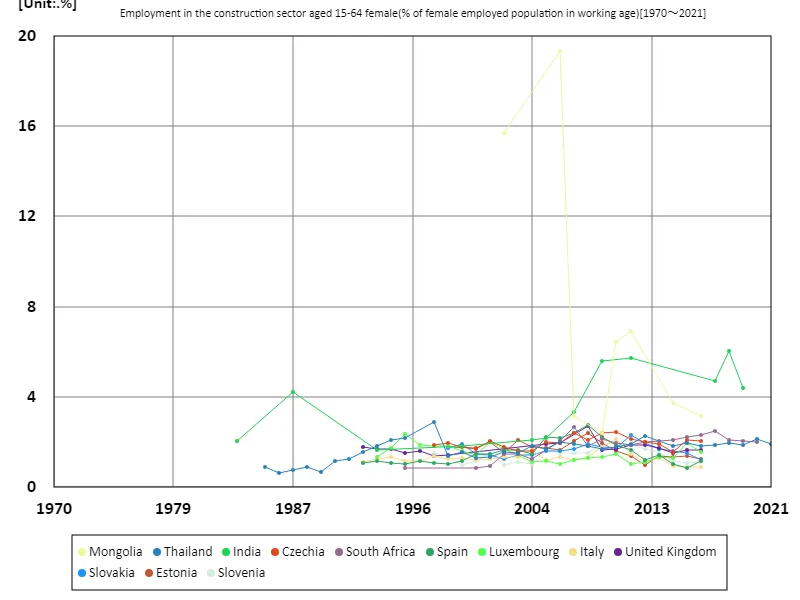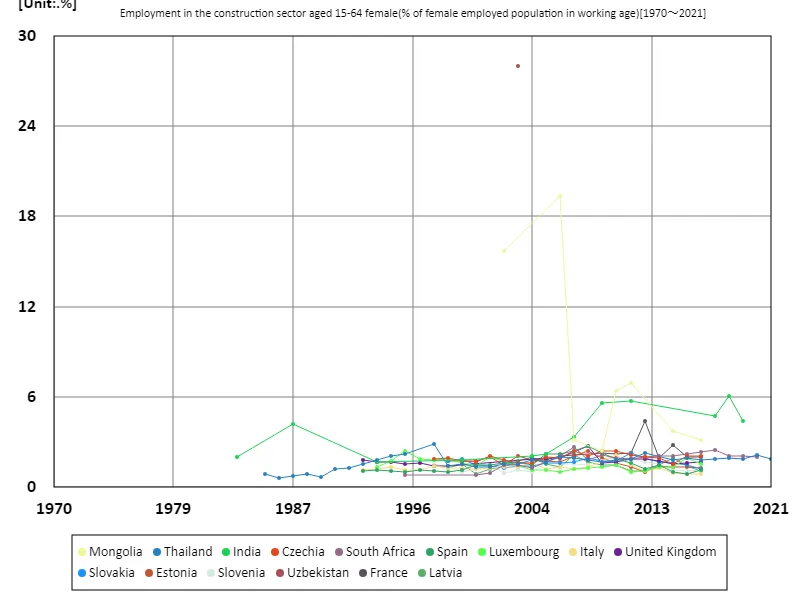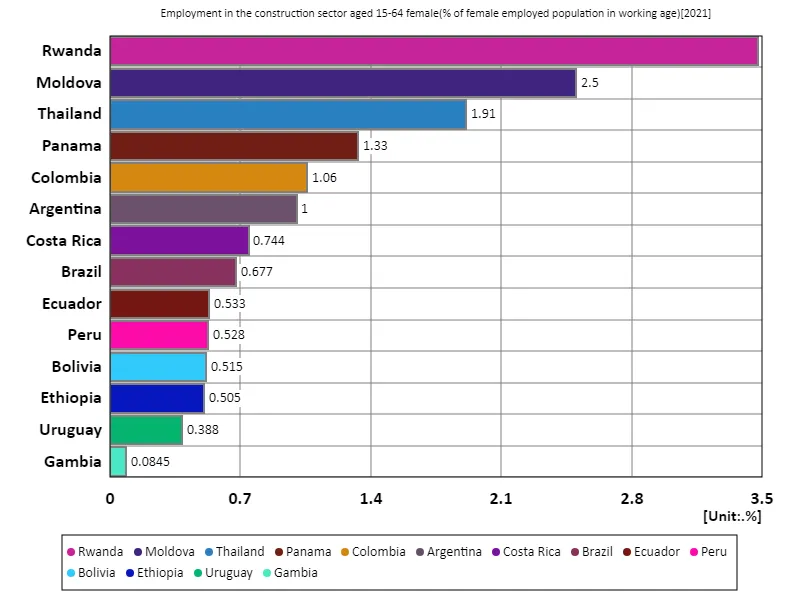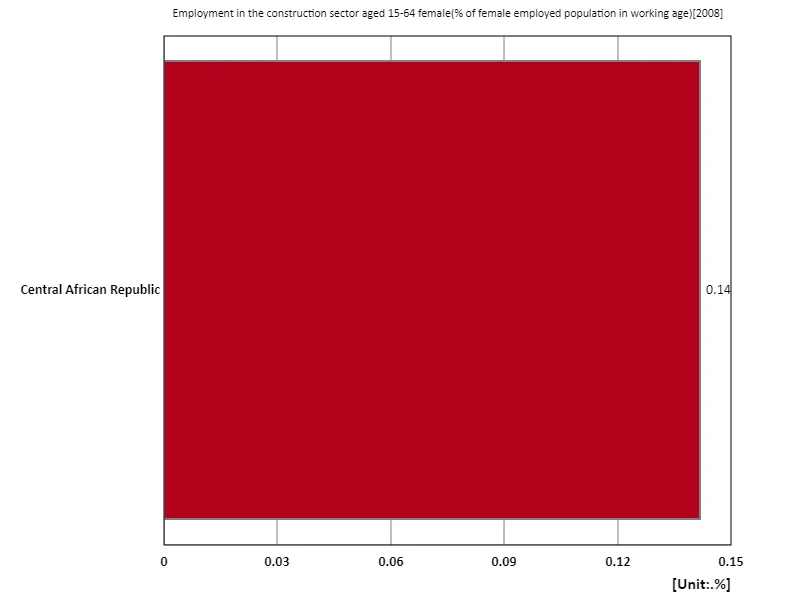- Abstract
- Employment rate in the construction sector for women aged 15-64 (percentage of working-age female employment in the workforce)
- Employment rate in the construction sector for women aged 15-64 (percentage of working-age female employment in the labour force) (Worldwide)
- Employment rate in the construction sector for women aged 15-64 (percentage of working-age female employment in the labour force) (World, latest year)
- Employment rate in the construction sector for women aged 15-64 (percentage of working-age female employment in the labour force) (region, latest year)
- Reference
Abstract
There are several factors that could explain why the construction sector has the highest employment rate among women aged 15-64 in Thailand at 1.91% in 2021. First, the construction industry in Thailand is growing rapidly, which is resulting in an increase in employment opportunities for women. In particular, with urbanization and infrastructure development, opportunities for women to enter the labor market are expanding. Additionally, Thai government policies and companies’ promotion of diversity are believed to be contributing to increased employment of women in the construction sector. Additionally, Thailand’s cultural background and education system are flexible when it comes to women’s career choices. The data shows that Thailand is actively utilizing the female workforce in the construction industry, with a relatively high employment rate compared to other countries.
Employment rate in the construction sector for women aged 15-64 (percentage of working-age female employment in the workforce)
Data from 1983 to 2021 shows that Mongolia’s employment rate in the construction sector for women aged 15-64 peaked at 19.3% in 2006 but has since fallen to 16.4%. Mongolia’s high peak employment rates are associated with a period of rapid urbanization and infrastructure development. During this period, the construction industry grew rapidly and a large labor force was required, which led to an increase in employment of women in particular. However, the subsequent decline is likely due to slowing growth in the construction industry, structural changes in the economy, as well as advances in technological innovation and automation. Additionally, the impact of economic fluctuations and policy changes on women’s labor markets cannot be ignored. Due to these factors, employment rates of women in the construction sector in Mongolia have declined from their peak. Overall, we can see that female employment rates in the construction sector have fluctuated across countries due to different economic backgrounds, policies and social factors. The case of Mongolia provides an example of the evolving role of women in the construction industry through rapid growth and subsequent change.


The maximum is 19.3%[2006] of Mongolia, and the current value is about 16.4%
Employment rate in the construction sector for women aged 15-64 (percentage of working-age female employment in the labour force) (Worldwide)
Employment in the construction sector among women aged 15-64 in Uzbekistan peaked at 28% in 2003, according to data from 1983 to 2021. This high employment rate is due to Uzbekistan’s rapid economic growth and booming construction industry at the time. This was a time when Uzbekistan was experiencing rapid development of urban infrastructure and housing construction, particularly as many women began to be employed in the sector. However, the current employment rate is 100% compared to its peak, marking a recovery to previous high employment rates and demonstrating that employment of women in the construction sector remains strong. This persistently high employment rate reflects Uzbekistan’s construction industry’s continued reliance on the female workforce. It is also possible that government employment promotion policies and changes in the labor market are contributing factors. Overall, the example of Uzbekistan shows that female employment rates in construction are closely linked to economic growth and infrastructure development, indicating that women’s role in the construction sector is highly dependent on a country’s economic situation.


The maximum is the latest one, 28% of Uzbekistan
Employment rate in the construction sector for women aged 15-64 (percentage of working-age female employment in the labour force) (World, latest year)
According to 2021 data, Rwanda recorded the highest employment rate in the construction sector for women aged 15-64 at 3.48%. This reflects the fact that women are increasingly entering the construction sector as Rwanda undergoes rapid economic growth and infrastructure development. The relatively high rate of female employment in the construction industry is likely due to government employment promotion policies and measures that support women’s advancement in society. With an overall average employment rate of 1.09%, female employment in the construction sector is relatively low. This may be due to the fact that the construction industry remains a male-dominated workplace and traditional gender roles. Additionally, the construction industry’s harsh working conditions and specialized skill requirements are also thought to be barriers to entry for women. The overall combined employment rate of 15.3% reflects the wide variation in women’s employment in the construction sector across regions and countries. It tends to be relatively low in developed countries, but can be relatively high in developing countries. While more women are entering the construction industry, there is still room for improvement and more work needs to be done to address gender inequalities.


The maximum is 3.48% of Rwanda, the average is 1.09%, and the total is 15.3%
Employment rate in the construction sector for women aged 15-64 (percentage of working-age female employment in the labour force) (region, latest year)
Data from 2008 show that the employment rate in the construction sector for women aged 15-64 in the Central African Republic was 142%, a figure that is unusually high. The unusual figures are likely the result of data errors, typos or calculation problems. In reality, it is theoretically impossible for female employment in the construction sector to exceed 100%, which is likely to indicate a data entry error or problems with the data collection and reporting process. The fact that the average and total are also 142% calls into question the integrity of the data. Typically, the employment rate of women in the construction industry is relatively low, and the construction industry is often a male-dominated workplace, especially in developing countries. Based on actual data, the employment rate of women in the construction sector typically remains at around 1% to a few percent in many countries. The reason such abnormal data is being reported is likely due to problems with data collection and reporting methods. In order to obtain reliable data, it is important to review data collection methods and establish accurate reporting methods. In addition, policy support and social change are needed to expand employment opportunities for women in the construction sector.


The maximum is 142m% of Central African Republic, the average is 142m%, and the total is 142m%



Comments